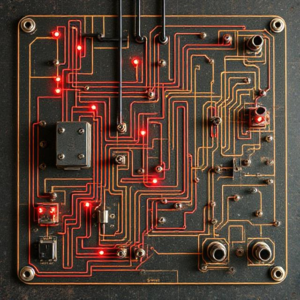Electric circuits are pathways through which electricity flows. There are different types of electric circuits, each having its own structure and characteristics.

1. Series Circuit
- What it is: In a series circuit, all components (like bulbs, resistors, etc.) are connected one after the other, forming a single path for the current to flow.
- Key features:
- The current is the same throughout the entire circuit.
- If one component (like a bulb) breaks or is removed, the entire circuit stops working because the path is broken.
- The total resistance of the circuit is the sum of the individual resistances.
- Example: Think of Christmas lights where, if one lightbulb burns out, the whole string of lights goes out.
2. Parallel Circuit
- What it is: In a parallel circuit, the components are connected in separate branches, so there are multiple paths for the electricity to flow.
- Key features:
- The voltage across each branch is the same.
- If one component (like a bulb) fails, the other parts of the circuit continue to work because the other paths remain intact.
- The total resistance is lower than in a series circuit because electricity can flow through more paths.
- Example: Household electrical systems are usually parallel circuits. If one light goes out, the others keep working.
3. Combination Circuit
- What it is: A combination circuit is a mix of both series and parallel circuits. Some components are connected in series, and others are connected in parallel.
- Key features:
- It combines the benefits of both series and parallel circuits, but it can also be more complicated to analyze.
- Some parts of the circuit will be affected by a break in the path, while others will remain functional.
- Example: In a complex electronic device like a computer, there are various parts connected in series and parallel.
4. Open Circuit
- What it is: An open circuit is a circuit where the path is broken, so electricity cannot flow.
- Key features:
- No current flows because the circuit is incomplete, like when you switch off a light or disconnect a wire.
- Example: A switch that is turned off or a wire that is unplugged.
5. Closed Circuit
- What it is: A closed circuit is a complete loop where electricity can flow freely.
- Key features:
- The circuit is fully connected, and current flows through it.
- Example: A light switch turned on, or a battery powering a device.
Recap of the Key Differences:
- Series circuit: One path; if one component fails, everything stops.
- Parallel circuit: Multiple paths; if one component fails, others keep working.
- Combination circuit: Mix of series and parallel connections.
- Open circuit: Path is broken, no current flows.
- Closed circuit: Complete path, current flows.
These are the basic types of electric circuits, and they are used in different situations based on how we want electricity to behave in the system.
Tags: circuit analysis, circuit behavior, circuit break, Circuit Components, Circuit diagram, circuit failure, circuit loop, circuit types, closed circuit, combination circuit, current distribution, current flow, Electric circuits, electrical design, electrical network, electrical pathways, electricity flow, electricity in circuits., electronic systems., electronics basics, energy distribution, household circuits, multiple paths, open circuit, parallel circuit, parallel connection, resistance, series circuit, series connection, single path, voltage, voltage across branches


